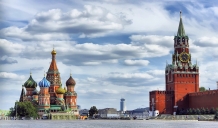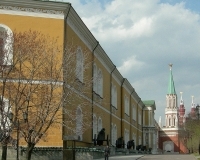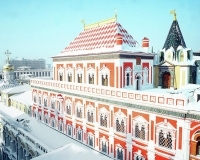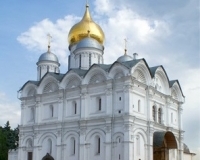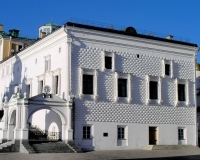The Kremlin and Red Square
The Moscow Kremlin is the oldest part of the city, the major public, political, historical and artistic complex in the capital of Russia. The Kremlin and Red Square are on the UNESCO World Heritage List.
Some monuments found in the Kremlin are closely associated with the name of Peter I. On June 9, 1672, a son named Peter was born to Tsar Aleksey Mikhailovich and Tsarina Natalia Kirillovna in the Terem Palace (1635–1637, 1499–1508) in the Kremlin — this was Peter I, the future Tsar (1682) and Emperor (1721) of Russia. On the occasion of his birth, boyars, chiefs of the Streltsy (shooters) and officials of the sovereign’s court were offered a treat in the Front Chamber of the Terem Palace.
The Terem Churches adjoining the palace were used as a place for confession and communion by members of the royal families and held prayers dedicated to the announcement of heirs to the throne. Tsarevich Peter and his mother visited the family chapels when they lived in the Terem Palace. In 1682, the temples were made the same height and fused together in their exterior by Osip Startsev. Multicolored tiles on the dome drums and magnificent openwork crosses make the building particularly elegant.
According to tradition, on the 29th of June, Tsarevich Peter was baptized in the Saint Alexius Church of the Holy Spirit Monastery established on the grounds of the Kremlin in 1365 and destroyed in 1829-1832. Fragments of the monastery buildings were found by archaeological excavations in 2016. The finds were mothballed, with two “windows” opened to visitors. One of them offers a display of the foundations and basement parts of two monastery churches in the area of 44 square meters.
The Dormition Cathedral in the Moscow Kremlin (1326–1327, 1475–1479; architect Aristotele Fioravanti) is the main church of both Moscow and Russia. It is the oldest fully surviving building in Moscow. The Cathedral was the place where great princes, tsars and emperors were crowned, bishops, metropolitans and patriarchs appointed, and major state acts announced. Even after the capital had been transferred from Moscow to Saint Petersburg, the Cathedral remained the coronation place for Russian monarchs. On May 7, 1724, Peter I crowned his wife Ekaterina Alekseevna to the Russian imperial throne for the first time.
The Cathedral also served as a burial place for Russian metropolitans and since the end of the 16th century also housed the tombs of patriarchs. After the death of Patriarch Adrian in October 1700, no Patriarch of Moscow was elected, but an exarch (a locum tenens of the patriarchal throne) was appointed instead. In 1721, Peter I abolished the patriarchate and established a permanent state church authority, the Synod. Since 1721, the Patriarch’s Palace (1652–1656) in the Kremlin housed the Moscow Synod Office.
The Cathedral of Archangel Michael (Arkhangelsky) in the Kremlin served as a family vault for great princes, tsars and tsareviches since old times. The existing cathedral (1505–1508; architect Aloisio the New) housed tombs of sovereigns until the capital was moved to Saint Petersburg. Since his childhood, Peter regularly attended commemoration services for his father and grandfather (the half-brother of Tsar Fyodor III) which took place in the Cathedral. On January 30, 1696, the Cathedral held the funeral service for Tsar Ivan V, the half-brother and co-ruler of Peter I. The ancestors, relatives and descendants of Peter I (grandfather, grandmother, father, mother, son Alexander, brothers, sisters, uncles, aunts, nephews and nieces, his grandson Emperor Peter II, and granddaughter Princess Natalya Alekseevna) rest in the necropolis of the Archangel Cathedral.
The archpriests of the Kremlin’s Annunciation Cathedral (built by builders from Pskov in 1484–1489) were Tsar’s confessors.
The Palace of Facets has the throne hall of Russian sovereigns which was built by order of Ivan III by Italian architects Marco Fryazin and Pietro Antonio Solari in 1487–1491. This is where meetings of the Boyar Duma and the Zemsky Sobor, feasts in honor of important state events and diplomatic receptions took place It is here that brothers Ivan Alekseevich and Peter Alekseevich were declared Tsars on demand of the Streltsy (shooters) on May 26, 1692. A double throne was installed in the Palace of Facets for the co-ruling brothers. Their joint reign continued until the death of Ivan in 1696. The Palace of Facets is the oldest surviving sample of civil architecture in Moscow and one of the oldest in Russia.
In 1648–1651, chambers were built for boyar Ilya Miloslavsky, the father-in-law of Tsar Aleksey Mikhailovich, near the western wall of the Kremlin, between the Komendantskaya (Commandant’s) and Troitskaya (Trinity) Towers. Stepsisters of Tsarevich Peter who were born in the Tsar’s first marriage with Maria Miloslavskaya began to live there in 1679. After the death of Ilya Miloslavsky, the chambers were transferred to the Crown and connected with the royal palace by stone passages. The building was adapted to house court theatre performance — “amusements” — and thus began to be called the Amusement Palace. A legend says that in the Amusement Palace, Peter had literacy and Scripture classes given to him by a scrivener from the Big Prikaz (Office) Nikita Zotov. The Amusement Palace is the only building of private origin surviving in the Kremlin.
The Arsenal is situated in the northern corner of the Kremlin, between the Nikolskaya (St. Nicholas), Uglovaya Arsenalnaya (Corner Arsenal) and Troitskaya (Trinity) Towers. The design of the building was based on a schematic plan made by Peter I himself. The Tsar’s decree to build the Arsenal with the attached drawing was made public in 1701. It was designed not only as an armament depot, but also as a museum of Russian military glory, as Peter ordered to bring and install there weapons captured in battles with enemies “as a memory of eternal glory”.
When waiting for a march of the Swedish troops to Moscow during the Northern War, on May 6, 1707, Peter I decreed to reinforce the old fortifications of the Kremlin. Pentagonal earth bastions were built in front of the walls and towers of the Kremlin. They existed through the first quarter of the 19th century. A fragment of the earth fortifications dating from Peter’s times can be seen in the Aleksandrovsky Garden, at the base of the Kremlin’s Oruzheynaya (Armory) Tower.
The Church of the Intercession, better known as the St. Basil’s Cathedral, in Red Square was built in 1555–1561 in commemoration of the conquest of the Kazan and Astrakhan khanates by Ivan the Terrible. In the 16th-17th centuries, the “donkey walk” — an Orthodox ritual procession symbolizing the entry of Jesus Christ into Jerusalem on a donkey — took place between the Assumption Cathedral and the Entry to Jerusalem side chapel of the Intercession Cathedral during the celebration of the Palm Sunday. Co-rulers Peter I and Ivan V took part in such processions between 1684 and 1693.
The Cathedral of the Kazan Icon of the Mother of God at the northern end of Red Square was built to commemorate the liberation of the Tsardom of Russia from the Polish-Lithuanian intervention in the second quarter of the 17th century. The original wooden building had been destroyed by fire and a brick church built using the funds of Tsar Mikhail Fedorovich was consecrated in 1636. On July 8 and October 22, the feast of the Kazan Icon, a cross procession with the participation of patriarchs and tsars, including Peter I, took place between the Assumption Cathedral and the Kazan Cathedral. Dismantled in 1936, the Cathedral was recreated in its original shape in 1990–1993.
A fenced circular stepped elevation known as the Lobnoye Mesto is found opposite the Spasskiye Gate of the Kremlin on Red Square. After the Streltsy uprising of 1698 intended to bring the sister of Peter I Tsarevna Sophia to the throne, a list of Streltsy’s crimes and the text of the sentence were put up near this place by order of Peter I. Peter, who was at that time traveling as part of the Great Embassy in Western Europe, returned to take part in the investigations. About two thousand participants of the riot were executed, more than 600 people were whipped, branded and exiled, the Streltsy troops were dissolved and Tsarevna Sophia was made a nun.


